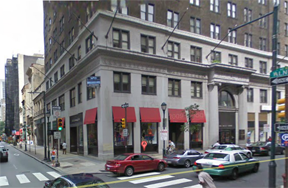PHILADELPHIA — Retail rents along Walnut Street have reached a new threshold — $100 a square foot and above — in a clear sign retailers are willing to pay up to reside along a key Center City shopping corridor.

The high rents underscore the rise of Walnut Street as Philadelphia’s lower-key version of Rodeo Drive, a place for high-end retailers to cluster and shoppers to be seen.
The list of posh retailers elbowing their way onto Walnut Street is growing, helping to push rents upward.
BCBG Max Azria, a fashion collection donned by celebrities, recently signed a lease that went substantially higher than $100 a square foot. The apparel maker leased 2,800 square feet at 1601 Walnut St. in a deal negotiated by Andi Pesacov, director of the retail division at Mallin Panchelli Nadel.
Among other retailers that have committed lately to $100-plus per foot leases along Walnut are Cole Hahn at 1600 Walnut, L’Occitane at 1606 and American Apparel at 1611.
In another deal, a high-end fashion house that caters to men and women that Pesacov would not identify, signed a lease recently on 10,000 square feet somewhere along Walnut. The retailer will pay $100 a square foot for street-level space and $50 a square foot on the second level.
These $100-plus retail rents are new to Philadelphia.
Six years ago, when Pesacov did her first retail deal with bebe, another fashion designer, rents in the 1400 block of Walnut were fetching $55 a square foot. Six months later, space in the 1700 block of Walnut jumped to $65 a square foot.
“They’ve been climbing steadily every six months,” she said.
For a while, however, rents stalled at $75 a square foot, making some wonder if they had peaked. Not so.
“Then it took off at $100,” Pesacov said.
Philadelphia still has a long way to go to catch up to the nation’s leading retail corridors. Rents along Fifth Avenue in New York command $950 a square foot, compared to San Francisco’s Geary Street, at $450 a square foot, Beverly Hills’ Rodeo Drive, at $300 a square foot, and Chicago’s North Michigan Avenue, which gets $245 a square foot, according to a 2005 Colliers International retail market report. Boston’s Newbury Street had per square foot rents come in at $130 and Washington, D.C.’s M Street had rents around $40.
The higher rent prices are indicative of a thriving city, its real estate and retail markets. For retailers, Philadelphia is no longer considered a second class market — where it lingered for years in an opinion that was exacerbated by 9/11 when retailers pulled back on expansion plans.
The city’s appeal and its retail spots have grown as more residents have moved in. Those residents, empty nesters and young professionals sans children, are buying expensive condominiums that start at $1 million. They have disposable income to spend on fancy dresses and suits and ties. Retailers are rising to the bait.
The higher rents along Walnut are having a spillover effect on Chestnut Street and the numbered streets crisscrossing Walnut and Chestnut. Chestnut is now showing rents in the $70 a square foot range, double what it was two years ago. Stores along the numbered streets are getting $50 a square foot and up.
Because of the higher rents on Walnut, boutique and small local retailers are being forced to relocate to Chestnut and the numbered streets, where it’s more affordable. That’s having an added effect by enhancing what was once a tired retail scene along those streets.
“It’s a pure example of Economics 101. It’s supply and demand,” said Steve Gartner, president of Metro Commercial Real Estate Inc., which works with retailers and landlords. “Retailers are doing well and new retailers want to follow them into the market. No retailer wants to be a pioneer, and now Walnut is a proven retail street. It is as proven as King of Prussia is as a mall.”
The strength of the street wouldn’t be if retailers along Walnut Street weren’t earning their rents. In fact, sales per square foot are higher on Walnut Street than Newbury Street in Boston, said Larry Steinberg, who oversees the Center City office of Michael Salove Co., a retail brokerage.
An even bigger indicator is that sales are up on weekends. Sales on Saturday and Sunday, which is a particularly strong day, are outpacing weekday sales, Steinberg said.
“When a city can support retail sales on a weekend, especially Sunday, it’s a barometer that shows incredible strength of the retail market,” Steinberg said, adding that it’s also a direct correlation to the increase in the city’s residential population and strong tourism industry.
These retail experts believe Walnut and the city’s retail environment will continue to thrive.
“Not only is it sustainable, but we see no end in sight for the increases,” Steinberg said. “As [Philadelphia] becomes a hip, fun destination, people and retailers will want to be there.”
Natalie Kostelni, Reporter
Philadelphia Business Journal





